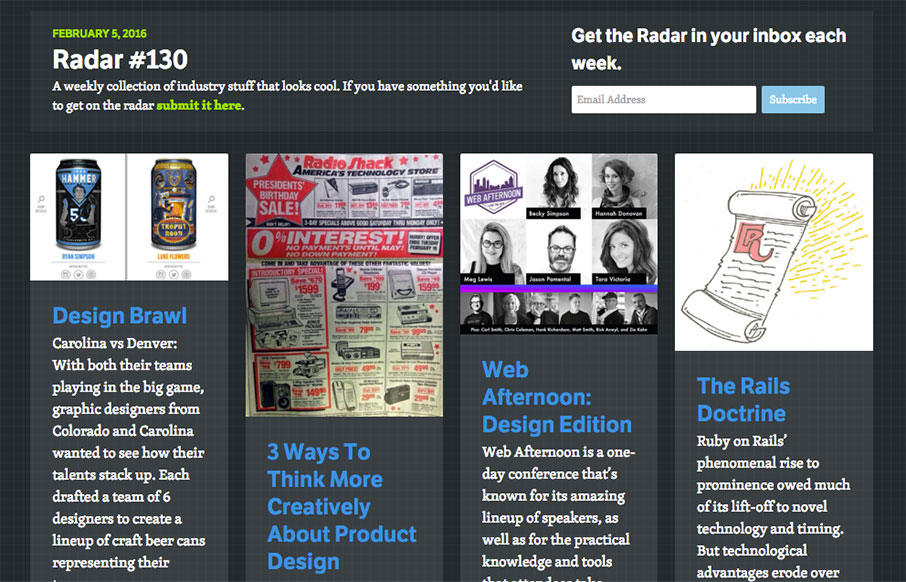Each week, we do a round up of curated “stuff from the interwebs” that we call Radar.
Design Brawl
Carolina vs Denver: With both their teams playing in the big game, graphic designers from Colorado and Carolina wanted to see how their talents stack up. Each drafted a team of 6 designers to create a lineup of craft beer cans representing their team.
3 Ways To Think More Creatively About Product Design
At first glance, many products may seem entirely unrelated. But, if you look closely, there is probably a point where their functions converge. Creativity lies at that intersection.
Web Afternoon: Design Edition
Web Afternoon is a one-day conference that’s known for its amazing lineup of speakers, as well as for the practical knowledge and tools that attendees take away. Web Afternoon’s goal is simple: to help designers be better at their jobs.
The Rails Doctrine
Ruby on Rails’ phenomenal rise to prominence owed much of its lift-off to novel technology and timing. But technological advantages erode over time, and good timing doesn’t sustain movements alone over the long term. So a broader explanation of how Rails has continued to not only stay relevant but to grow its impact and community […]
The Illusion of Completeness: What It Is and how to Avoid It
Users can think they see the entire web page, although additional content exists off-screen. Designers must help users discover all relevant information.
Why The Hell Would I Use Node.js?
Why use Node.js? If your use case does not contain CPU intensive operations nor access any blocking resources, you can exploit the benefits of Node.js and enjoy fast and scalable network applications. Welcome to the real-time web.
Understanding CSS3 Flexbox for Clean, Hack-Free Responsive Design
Remember how hard it used to be to vertically center content on your site? If you’re struggling with the words “used to be” in that last sentence, you obviously haven’t cottoned onto flexbox yet and need to read on.
Google Chrome is About to Get Faster Than Before!
If you are a Google Chrome user, there is good news for you. Your web browser is about to get faster and better than ever, all thanks to a new data compression algorithm that Google is planning to roll out soon.
How I Sped Up My Site 68.35% With One Line of Code
One of my obsessions as of late has been page speed. A more technical client early last year made me realize I’d phoned it in for the page speed recommendations that I’d been including in my SEO Site Audits. You know the ones, minifying code, removing inline styles and JavaScript, specifying image dimensions, leveraging compression, […]
Best Practices for Content Planning in UX Design
Which came first, the content or the design? This contemporary take on the “chicken and egg” casualty dilemma represents a common frustration among content and design teams when it comes to building a new experience. Both depend on each other, but where do you begin?
Setting Up a Mac Dev Machine From Zero to Hero With Dotfiles: Part 2
Hello and welcome to a second edition of Setting Up a Mac Dev Machine From Zero to Hero With Dotfiles. This article will go over what’s changed, with some added tips and tricks along the way. After reading this article you’ll be well on your way to getting a new Mac up and running as […]
If you want to add something to next week’s Radar – submit it here.
Here’s the link to this week’s batch of goodness: Radar #130.





0 Comments